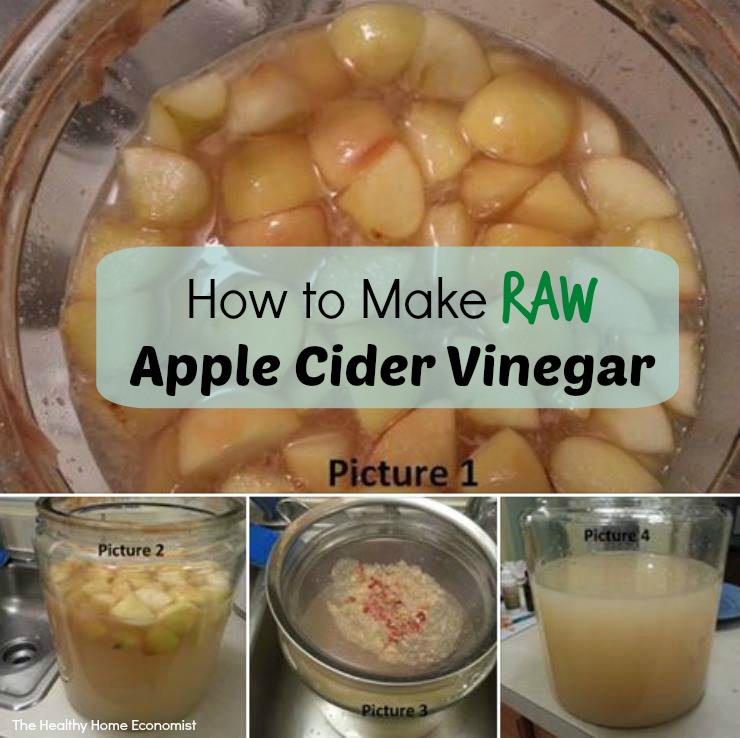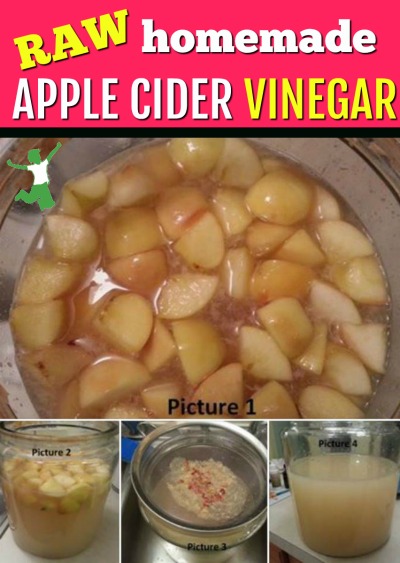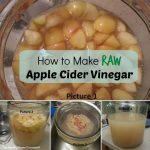How and why to make apple cider vinegar that is raw, enzyme and probiotic-rich for all your detoxification, cooking, and medicinal needs. This recipe uses raw honey, which makes the final result even more healthful and potent.
It’s apple season in many parts of North America which will continue through the Fall. Time to take advantage of the seasonal bounty and make some raw apple cider vinegar! If you don’t have locally grown apples available in your community, a bag of organic apples from the health food store or veggie co-op will work just fine.
Unpasteurized, or raw apple cider vinegar is expensive, so making your own is very thrifty. A typical quart of organic, raw apple cider vinegar will run you $5 or more at most health food stores. You can make a whole gallon, four times that amount, yourself for about the same price or even less if you use apple scraps that you were going to throw out or use for composting anyway.
Which Apples Make the Best Raw Apple Cider Vinegar?
A mixture of apples produces the best tasting and most healthful raw apple cider vinegar. Making it is very similar to kombucha. If you’ve made this or other fermented beverages before, you will find the process simple.
If homebrewing is new to you, try these approximate ratios for your first batch or two and then change it up from there to your own personal liking:
- 50% sweet apples (Golden Delicious, Fuji (my fave), Gala, Red Delicious)
- 35% sharp tasting apples (McIntosh, Liberty, Winesap, Northern Spy, Gravenstein)
- 15% bitter tasting apples (Dolgo crabapples, Newtown, Foxwhelp, Porter’s Perfection, Cortland)
In my neck of the woods, bitter-tasting apples are hard to find. If this is your predicament as well, simply increase the proportion of sweet apples to 60% and the sharp-tasting apples to 40%. While the flavor of this mixture won’t be as complex as with the inclusion of some bitter apples, it will still taste fine.
If all you have is a single apple tree in the backyard, however, feel free to use just that one variety to make your raw apple cider vinegar!
Uses and Benefits
The uses for raw apple cider vinegar are seemingly endless. It’s widely used in homemade tonics, recipes and even for cleaning. I like to use it for detox bathing (1 quart to a tubful of warm water). Friends of mine use raw apple cider vinegar as a hair rinse or for a natural, at-home hair detox.
The well known Master Tonic, a natural flu anti-viral, uses raw apple cider vinegar as the fermenting medium. It’s also an essential ingredient in all types of bone broth made at home.
Pasteurized apple cider vinegar doesn’t have the same benefits as raw apple cider vinegar. Valuable vitamins, probiotics, and enzymes are destroyed by the heating process. If you are going to go to the trouble of making apple cider vinegar, always make it raw for maximum benefits. Another problem with pasteurized ACV in the store is that it is frequently packed in plastic. The acidic ACV leaches chemicals into the vinegar! If you must buy apple cider vinegar, always buy it packed in glass.
How to Make Raw Apple Cider Vinegar
The recipe below outlines step by step instructions on how to make apple cider vinegar that is potent enough to use for all your medicinal, detoxification, cleaning and cooking needs. It is no doubt the most beneficial vinegar to have in your home followed by traditional balsamic vinegar.
Please always store any type of vinegar in glass containers. Storing in plastic risks leeching contaminants into your cider vinegar.
3 Medicinal Uses
Your homemade apple cider vinegar can be used not only in the kitchen and for cleaning. Try it in a vinegar bath (2 cups per tubful) to greatly aid detoxification.
It works much better than a skin-damaging bleach bath for relieving eczema symptoms too.
To ease acid reflux symptoms and for a natural cal/mag supplement, soak crushed eggshells in your homemade ACV to make a simple eggshell and apple cider vinegar remedy. 1 teaspoon in 8 oz of water up to 3 times a day works wonders.
DIY ACV can also be used to make a vinegar compress for sprains and bruises. This is what people used before ice was readily available, and believe it or not, raw vinegar works extremely well!

How to Use the ACV Mother
After you’ve made a few batches of ACV at home, you may notice that you have a number of vinegar mothers stacking up! What to do with them?
First of all, know that these are living cultures that have a number of beneficial uses around the home. Here are some suggested ideas instead of just throwing them out:
- Share them with friends so that they can make their own apple cider vinegar too!
- Use them as a gentle, rejuvenating face mask.
- Add them to the compost bin for fertilizing the garden.
- Dry them out at a low temperature (less than 150 F/ 65 C) in a food dehydrator or a warm oven. The low temperature will preserve any food enzymes as well as the probiotics. After drying, cut them into strips and eat them like fruit leather. Store in an airtight container in a cool pantry or the refrigerator.

Apple Cider Vinegar Recipe
Step by step instructions on how to make apple cider vinegar that is raw, enzyme and probiotic rich for all your detoxification, cooking, and medicinal needs.
Ingredients
- 5 large apples or scraps of 10 apples, preferably organic
- filtered water
- 1 cup raw honey preferably local and organic
Instructions
-
Before you can make your raw apple cider vinegar, you must first make hard apple cider. The alcohol in the hard cider is what transforms via fermentation into acetic acid, which is the beneficial organic compound that gives apple cider vinegar its sour taste. Nature is amazing!
-
Wash the apples and coarsely chop into pieces no smaller than 1 inch. Cores, stems and seeds may be included.
-
Put the chopped apples into a 1 gallon, clean, wide mouth, glass jar. Please do not brew your apple cider vinegar in stainless steel pots, as the acidic vinegar will causing leaching of heavy metals such as carcinogenic nickel.
-
The chopped apples should at least fill half the container and maybe a bit more. If at least half the container is not filled, add additional apple scraps until you achieve this level as a minimum.
-
Pour in room temperature filtered water until the chopped apples are completely covered and the container is just about full leaving a couple of inches at the top.
-
Stir in the raw honey or cane sugar until fully dissolved.
-
Cover the top of the glass jar with cheesecloth, a thin white dishtowel or floursack cloth and secure with a large rubber band.
-
Leave on the counter for about 1-2 weeks, gently mixing once or twice a day. Bubbles will begin to form as the sugar ferments into alcohol. You will smell this happening.
-
When the apple scraps no longer float and sink to the bottom of the jar after approximately one week, the hard apple cider is ready. If for some reason, the apple pieces still do not sink to the bottom after 2 weeks but the mixture smells alcoholic, proceed to the next step anyway.
-
Strain out the apple scraps and pour the hard apple cider into a fresh 1 gallon glass jar or smaller sized mason jars of your choosing.
-
Cover with a fresh piece of cheesecloth and secure with a rubberband.
-
Leave on the counter in an out of the way spot for an additional 3-4 weeks to allow the alcohol to transform into acetic acid by the action of acetic acid bacteria (these are the good guys!). A small amount of sediment on the bottom is normal. In addition, a mother culture will form on top, similar to what happens with kombucha.
-
Taste your raw apple cider vinegar to determine if it is ready starting after 3 weeks. If it has the right level of vinegar taste for you, strain it one more time and store in clean, glass mason jars or jugs. After 4 weeks, if the taste still isn't quite strong enough, leave it for another week and try again. If you accidentally leave it too long and the taste is too strong, just strain and dilute with some water to a level of acidity that pleases you.
-
Use as desired and store in the pantry out of direct sunlight.
Recipe Notes
Cane sugar may be substituted for raw honey if desired. Using raw honey will result in the healthiest apple cider vinegar, however.
Raw apple cider vinegar doesn't go bad, but if you leave it for a long time, another mother culture will likely form on top. This is fine, just strain it again if desired and dilute with a bit of water if the taste has become too strong.








I never heard of this way of making apple vinegar. Sounds interesting.
The way i do it is that i juice the organic apples, put the juice in container and cover with musslin.
After one month I open ( there should be foam on top) and strain it. Return the juice to container, cover, and leave it for another month. When vinegar is ready it should be clear from foam and the apple bits will set on bottom. I then again strain it and its ready to use. Even when you strain it in glass bottles still it will be apple vinegar with mother.
I never add, water, sugar as some recipes suggest or adding bacterias
First attempt a ACV and at first straining stage. Apples never dropped but it does smell alcoholic. Problem is when I strained it was thick and slimey. Should this happen or have I made an error in the process ?
We made ACV for the first time last year. We have about 1/2 gallon left. I went to pour some out and the flavor has diminished almost tasting like water instead of ACV. I thought it would keep getting stronger. Can it go bad and is it okay to use?
Thanks
I tried to make it. I stirred it after a week. The next day it grew: it was a foam soaking the cloth on top, not liquid anymore. What happened? Thank you.
Jennifer, I never ever use cheesecloth to cover my ferments. It is too open of a weave and fruit flies and gnats fly right through it. I suggest you try using coffee filters or even a piece of an old (clean, of course) t-shirt or dishcloth. Also make sure that you use a very tight rubber band that is successful at squeezing the filter or cloth tight to the side of the jar.
Just drained the apples off mine two days ago and it is a cloudy liquid now. From the images I have seen on You Tube, it supposed to look cloudy if it is raw acv. ????????
Mine did not form a mother. Is this ok or could there be something wrong? It tastes and smells like acv.
Hi, it does not look like many questions get answered on here, but I took the time to go through ALL of the comments because I am having the same problem you are having. Apparently waaaaay back, the author of this post recommended straining apples after two weeks if they are still floating and your mixture smells like alcohol. Hope this helps, and just know that you are not alone. Very few people had their questions answered.
I’m working on some ACV from peels and cores right now. I’m about 9 days in. Stuffed glass gallon jars mostly full of peels and cores (maybe too much?), added honey and DI water. Been shaking daily, smells kind of like apple hooch right now. Question is … the liquid seems crazy viscous – like a sticky mucilage and not a thin vinegar. No off odors, no suspicious molds. Has been bubbling along a-okay, apples haven’t dropped just yet. I diluted it down today between two gallon jars and added some starter from another mother culture of ACV that formed over time in my Braggs. So, what’s going on? Should I be worried? Will it clear up?
Dear Sarah (or anyone who can help),
I made mine with both peels and chunks. It had been one week and they have not sunk. I’ve been tasting it every day to see if it tastes alcoholic. Am I slowing the process by tasting it because I’m probably taking out some of the fermenting germs? Also it has an odd taste to it like slightly sour but not alcoholic. A response would be really appreciated.
Sincerely,
Eli